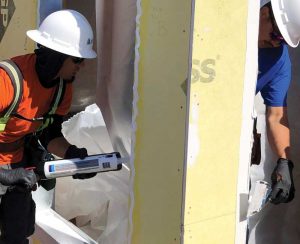
By Aaron Blom
A weathertight building enclosure is critical when it comes to preventing air leakage and water penetration. It also significantly impacts energy efficiency, indoor air quality (IAQ), and occupant comfort. Therefore, properly specifying and detailing the transitions between fenestration products and the surrounding wall conditions is extremely important.
Flashing is what enables the fenestration product to be integrated with the exterior facing material, sheathing, and the water-resistive barrier (WRB) to ensure the integrity of the drainage plane and prevent unintended water penetration.
To help designers specify and detail the correct flashing products, the Fenestration and Glazing Industry Alliance (FGIA) recently updated two flashing standards: AAMA 711, Specification for Self-Adhering Flashing Used for Installation of Exterior Wall Fenestration Products and AAMA 714, Specification for Liquid Applied Flashing Used to Create a Water-Resistive Seal Around Exterior Wall Openings in Buildings.
Self-adhering flashing
In addition to providing the minimum performance requirements of self-adhering flashing for common exterior fenestration products, AAMA 711 offers a method for determining the flashing product’s minimum width and evaluating environmental factors when installing the flashing under typical field conditions.

Applicable for new construction as well as replacement installations, this standard provides guidance on properly evaluating, selecting, and installing flashing for durable adhesion around the perimeter of exterior fenestration systems. Due to the importance of proper adhesion, testing of these products for adhesion to specific substrates is included. However, AAMA 711 does not address chemical compatibility, and this should be verified by the flashing manufacturer. AAMA 713, Voluntary Test Method to Determine Chemical Compatibility of Sealants and Self-Adhered Flexible Flashings, could be used to assess the chemical compatibility of self-adhering flashing with liquid applied sealants.
Before reviewing the test requirements and installation guidance provided in this standard, it is important to better define what qualifies as self-adhering flashing. These products are flexible facing materials coated completely or partially on at least one side with an adhesive material and are not dependent on mechanical fasteners for attachment.




